Buyer's Guide to Treadmills
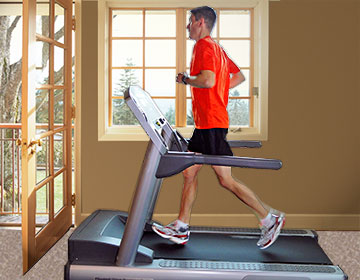
If you want an amazing aerobic workout in the comfort of your home, a treadmill is a fantastic choice. Walking, jogging and running on a treadmill can deliver impressive cardiovascular improvement, effective weight-bearing exercise for your bones, top-notch toning for your legs and a great way to burn calories and fat.
And you've chosen the ideal time to shop for a new treadmill for your home. These days, manufacturers are offering a wide range of user-friendly treadmills in varying price points, all designed to offer you a high-quality treadmill with the features you want and need.
You Have Plenty of Choices in Treadmills
Don't be overwhelmed with all the choices available to you. This comprehensive guide walks you through all aspects of choosing a treadmill and helps you determine what features are important to you, and what you can live without.
You may find you need a treadmill with a large motor and spacious running surface, while someone else is focused more on the shock absorbing and console programming options. After you determine the treadmill qualities and features that are important to you, it's just a matter of trying out the treadmills that meet your criteria, and choosing the machine that will serve you the best.
A Few Questions
Before you visit our shop, ask yourself a few questions so that you're better equipped to make this important decision and find your new treadmill:
- Who will be using your treadmill?
- How will your treadmill be used (walking, jogging or running)?
- How often will your treadmill be used (daily, seasonally, year-round)?
- What are your (and other users') goals?
- Where will you put your treadmill?
Also keep in mind your exercise history, the reason you're buying the treadmill and the goals you hope to accomplish. If you've previously used treadmills or other cardio machines, consider what features you enjoyed before, such as incline, shock absorption, workout programs and heart-rate monitoring. And consider that the commercial treadmill you may have used in a health club or recreation center is likely priced near $10,000 or more. While it's unrealistic to expect the exact same treadmill experience for only a fraction of the cost, you can find a great number of high-quality, home treadmills that will deliver a similar experience.
And, if you're new to treadmills, beware falling into the common trap of buying a cheap treadmill just to see if you'll use it. The problem here is that you'd be setting yourself up for failure with a hard, unstable and noisy treadmill that will disappoint you with every step. As you're more likely to repeat a good experience than a bad one, go with a treadmill that's more likely to feel comfortable and deliver a positive outcome.
When deciding on your new treadmill, you should take into account who will be using it now and in the future. Initially, you may be the primary or only user. But, a high-quality treadmill will serve you well for many years to come. You might have young children now that will find athletic or fitness benefits from the treadmill as they grow older. Your healthy behavior may inspire others to begin walking or running on the treadmill. And your original workout mode might be walking, but that could turn into a jog or a run as you gain fitness, lose weight or gain confidence.
Durability
A treadmill is one of the only products that you buy with the express purpose of walking or running on it! As such, durability should always be one of your key criteria when selecting a new treadmill. Durable treadmills include motors that run quiet and cool, frames that are sturdy and stable, and quiet belt/deck combinations without excessive friction. You should focus on attaining the most durability and reliability your dollar can buy if your treadmill will be used by:
- Heavier users
- Multiple users
- Daily or consistent users
- Higher-mileage runners
- Runners doing long runs
The Drive Motor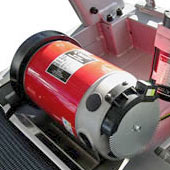 More than any other feature, treadmill shoppers tend to be concerned about the size of the motor. And their concerns are justified, as the drive motor is a key component of the treadmill, and it's crucial that your treadmill is equipped with a motor that fits the needs of all users. Generally, a larger, quieter motor tends to perform better and last longer, as a stronger motor typically runs cooler, and a lower noise level usually indicates the drive system is absorbing less wear and tear.
More than any other feature, treadmill shoppers tend to be concerned about the size of the motor. And their concerns are justified, as the drive motor is a key component of the treadmill, and it's crucial that your treadmill is equipped with a motor that fits the needs of all users. Generally, a larger, quieter motor tends to perform better and last longer, as a stronger motor typically runs cooler, and a lower noise level usually indicates the drive system is absorbing less wear and tear.
That said, as long as a treadmill boasts a 2-HP (or larger) continuous-duty motor, the quality and compatibility of the drive system as a whole (drive motor, motor controller, balanced flywheel, belt, deck and rollers) is most critical. A larger, more efficient motor will also hold up better under heavy use and heavier users.
Treadmills that have less than a 2-HP continuous-duty motor should generally be reserved for lighter use (less frequent and walking only) and lighter users.
Treadmill Frame Construction
Treadmill frames are typically either constructed of steel or aluminum, and it's important to note that you can find examples of sturdy, top-quality treadmills constructed of each of these 2 strong metals. Aluminum-framed treadmills tend to be lighter, so they are sometimes easier to move around. Steel-framed treadmills are usually heavier, and this additional heft can sometimes provide a more solid platform for your workouts. It's important to choose a treadmill that feels stable and solid during use. And again, heavier users and/or heavy use warrant a sturdier frame.
Belt and Deck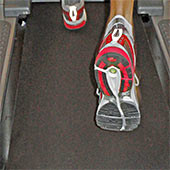
For most people, a 20- to 22-inch wide belt provides a safe, comfortable width for running and walking, and fortunately, that's a very common width found on high-quality home treadmills. A width of 18 inches may be satisfactory, but anything less will significantly reduce your margin for error while exercising on your treadmill.
Most belt lengths range between 50 to 60 inches, and you should consider focusing your choices on a treadmill with a belt at the longer end of this range if:
- You're tall
- You have a long stride
- You plan to run on your treadmill (especially with higher top speeds)
- You're accustomed to a longer running surface
- You prefer greater peace of mind
On a high-quality treadmill, there's good news when it comes to belt/deck durability. Like tires on a car, the treadmill belt and deck can wear out down the road. But if you can run or walk the thousands of miles that it takes to wear out the belt and deck on a high-quality treadmill, you'll be in great shape! And a number of manufacturers even outfit their treadmills with a reversible deck for double the lifespan.
Folding Treadmills
If you have limited space available in your home, a folding treadmill can be essential. And better folding treadmills are being manufactured today than ever before. However, you should keep in mind that a folding treadmill typically exhibits the same active footprint as a non-folding treadmill. Also, you should consider that u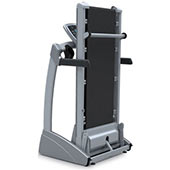 nless the front of your treadmill is positioned directly against a wall, you'll still be left with a treadmill in the middle of your room when you fold it up. Most treadmills do include transport wheels, but moving the treadmill will require some work that you may be unwilling to do between workouts.
nless the front of your treadmill is positioned directly against a wall, you'll still be left with a treadmill in the middle of your room when you fold it up. Most treadmills do include transport wheels, but moving the treadmill will require some work that you may be unwilling to do between workouts.
A folding treadmill will free up some potentially valuable floor space when not in use. You should also know that (with a few exceptions) folding treadmills are less stable and typically cost more than similarly featured non-folding models. If you expect your treadmill to handle heavy use (frequent and jogging/running) and heavy users, you should select the most-stable of the folding treadmills, or go with a non-folding model.
Shock Absorption
There's great news for your joints! Most treadmills now feature some level of cushioning or shock absorption. At a basic level, you should search for a treadmill that feels comfortable while you're walking or running on it. You should avoid treadmills that deliver more bounce than true cushioning, as bouncing decreases stability and adds detrimental vertical travel to your stride. Thicker, orthopedic belts provide some additional cushioning, but like a running shoe's midsole, the majority of the shock absorbing occurs between the treadmill's deck and frame.
If you truly want to take care of your joints, select a treadmill that sports a floating, or suspended, deck that is connected to the frame with several individual elastomer or rubber shock absorbers. Some treadmills even offer user-adjustable shock absorbing, allowing you to customize the feel of your treadmill to meet your needs, and those of other members of your family. If a manufacturer offers models with and without this adjustment, make sure each potential user tests out each variety, as the non-adjustable model may feature the shock-absorbing level you would choose anyway.
Treadmill Noise
As you're running or walking on top of a motorized machine, treadmills are going to make some noise. However, better treadmills will generally run quieter. One thing to keep in mind is that how a treadmill sounds in the store may not accurately reflect how it will sound in your home. You'll likely be placing your treadmill in a smaller room, with lower ceilings and different flooring.
And, you should expect a temporarily louder running belt when your treadmill is first assembled. This noise will decrease as you use your treadmill. You should also know that with a high-quality treadmill, the loudest noise will likely be the sound of your foot strikes. To limit all treadmill noise, we highly recommend placing your treadmill on an equipment mat or rubberized flooring.
Speed and Incline
When contemplating what your speed and incline needs are, you need to carefully consider what workouts you and others will be performing now and in the future.
Most good treadmills will provide a top speed of at least 10 mph (6-minute miles). For many treadmill users, this will be quick enough for all of their steady workouts and potential interval sessions. Many runners may want a little more speed, and a number of treadmills feature a top speed of 12 mph (5-minute miles) or more, coming in handy for intervals, tempo runs and 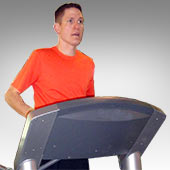 more.
more.
The majority of high-quality treadmills boast an incline of at least 12 percent. If you've walked or run for a few minutes or more at a 12-percent grade (on a treadmill or outdoors), you realize how easily you can elevate your heart rate and get your leg muscles burning.
One of the great aspects of treadmill training is that you can maintain a low to moderate speed and crank up the incline for a truly vigorous workout with very little impact to your joints. A number of good treadmills will ramp up to 15 percent, which can be quite effective for a self-created hill workout or built-in workout programs involving short periods of time at the upper inclines.
Console Display and Controls
When checking out different treadmill consoles, primarily focus on finding a user-friendly interface and satisfactory workout feedback. Many runners want to see their pace displayed in minutes per mile (instead of speed in miles per hour), others aren't satisfied without a workout profile or track view, while still others would prefer a constant readout of calories burned or calories per hour. Most exercisers are driven by a goal of some kind, and if there's a piece of workout data that helps drive you towards your goal, make sure that crucial feedback is included on your new treadmill's console.
The layout and functionality of a treadmill's controls can affect how much you'll enjoy your workout. Make sure that you're comfortable with the speed controls, incline controls and stop button, as you'll use these buttons the most during your workout. Quick keys are now included on a great number of treadmills, delivering near-instant access to a number of preset speeds and inclines. Some treadmills even come equipped with speed and/or incline controls mounted on the side rails or handlebars.
More and more treadmill consoles are equipped with additional features designed to enhance the user experience, including:
- Built-in reading racks help treadmill users to catch up on their reading and pass the time while walking (most runners don't find reading while running to be possible, practical or safe).
- Integrated fans keep users cool, which makes the workout more enjoyable and potentially lengthens workout time.
- Varying levels of iPod/MP3 compatiblity or connectivity provide audio and/or video entertainment to motivate, help workouts fly by, and maintain training intensity.
Another item often found on the console is some form of built-in reading rack. It's not practical (or safe) to read while running, but many treadmill walkers catch up on their reading and quickly pass the time while exercising.
Heart Rate
Heart-rate monitors are included on many treadmills for the purposes of tracking your workout intensity. You can exercise at a heart rate (or heart-rate range) specifically chosen to maximize efficiency for a variety of goal-based workouts, including:
- Burning calories and fat
- Following a personal fitness plan
- Exercising safely per a physician's prescription or recommendation
- Improving your sport-specific fitness
- Building endurance for cardiovascular health
- Recovering from a previous workout
Treadmills monitor your heart rate through contact hand sensors and/or wireless telemetry straps. Here's a quick breakdown of how and why each system is used:
| Contact Hand Sensors | Wireless Telemetry Strap |
Contact heart-rate monitoring uses hand sensors usually found on the front handlebars or side rails. After gripping the hand sensors for several seconds, your heart rate will be displayed on the console. If you just want to periodically check your heart rate, or don't prefer to wear a heart-rate strap, a treadmill that features contact heart rate may be right for you. | A telemetry heart-rate system provides the most-accurate monitoring. It utilizes an adjustable, wireless strap worn around your chest that picks up an electrical impulse from your heart and sends a radio frequency signal to the console. This hands-free system allows a constant heart-rate readout on the console, making it especially useful when performing the built-in, interactive, heart-rate control programs available on many treadmills. These programs use automatic incline and/or speed adjustments to maintain or vary your heart rate. The most common heart-rate control programs are designed to either maximize fat-burning or improve cardiovascular fitness. |
Stand-alone heart-rate monitors are also available, offering you the ability to accurately monitor your heart rate on a treadmill (or any fitness equipment) without built-in heart-rate monitoring, or while exercising outdoors. (These are sold separately.)
Console Programming
Treadmill programming can take a repetitive aerobic exercise and transform it into a dynamic, challenging hill session, an invigorating interval session or a scientifically based, heart-rate control program. Programs automatically adjust a treadmill's speed and/or incline to deliver a variety of courses and workouts. Popular program choices include:
- Random
- Intervals
- Hills
- Heart-rate control
- Preset distance courses
- Goal-based
- Fitness tests
- User-defined (custom) courses
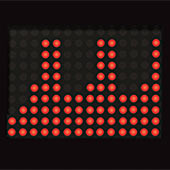 If you've had success using a specific treadmill program at the gym, chances are you'll be able to find a similar program on a treadmill for your home. Many treadmill users at the gym will just hop on the treadmill and press the quick-start button for a manually controlled workout. But after your treadmill is assembled, you'll have time to read the owner's manual, explore the programming options and learn how a key program can keep you motivated and enhance your entire fitness regimen.
If you've had success using a specific treadmill program at the gym, chances are you'll be able to find a similar program on a treadmill for your home. Many treadmill users at the gym will just hop on the treadmill and press the quick-start button for a manually controlled workout. But after your treadmill is assembled, you'll have time to read the owner's manual, explore the programming options and learn how a key program can keep you motivated and enhance your entire fitness regimen.
Plus, many treadmill manufacturers make it easier than ever to use workout programs by incorporating a user ID function. Depending on the treadmill, a user ID may let you:
- Store personal data (age, weight, etc.) for a quick, user-specific start to workout programs.
- Store workout data, allowing you to track your workout totals, progress, and even personal bests.
- Memorize workouts, letting you repeat (or even compete against) previous favorite workouts.
So, don't underestimate the ability of a good treadmill program to motivate, distract and entertain you while you march towards your fitness goals.
The Fun Part: The Test Drive!
Now that you have a better idea of what you're looking for in a treadmill, it's time for the test drive! We highly recommend you (and anyone else who will be using the treadmill) try out any treadmill in the specific manner you'll use it in your home. Doing anything less will provide you with limited feedback and potential disappointment. Here are some tips and questions for you:
- If you're going to be running, don't just stop at walking on a treadmill in the store. How much will that really tell you? Bring your running shoes and run on it.
- Spend enough time to see how a treadmill feels and sounds when you walk and run on it.
- Are you comfortable with the size of the running surface?
- How does the shock absorbing feel?
- Do you find the side rails or front handlebars useful or just in your way?
- Play with the speed controls and make sure you're satisfied with how quickly the belt speed adjusts.
- Does the treadmill feel sturdy and stable throughout the full range of incline?
- Are the treadmill controls easy to use while walking or running?
- Is the key workout statistic you're interested in constantly displayed or only shown periodically as the console display scans?
- If reading during your workout is important to you, bring along some favorite magazines to test out the reading rack.
- Will the treadmill fit where you want to put it in your home? Bring a tape measure, and be sure to determine your head height at its peak position.
Mats or Flooring
When setting up a treadmill in your home, we strongly recommend placing it on an equipment mat or rubberized flooring for the following reasons:
- It helps prevent static electricity issues from affecting the treadmill or user.
- It keeps your treadmill clean and prevents dirt, dust, pet hair, carpet fiber and other debris from causing additional wear and tear on your treadmill's motor and entire drive system (it's important to note that you should periodically vacuum the mat surface and surrounding area).
- It protects your flooring from the treadmill and keeps your treadmill from shifting.
- It helps insulate and reduces some of the treadmill's noise.
Thanks for reading. We look forward to helping you make this important step on the road to improved fitness!
